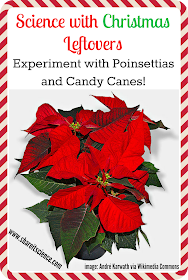Although you could do any of these science investigations before Christmas, they are also great to do with the "leftovers" like all the candy canes and beautiful poinsettia plants. Did you know you can use poinsettia in a pH experiment around the house or in the classroom? Read on for this investigation and several other fun ones for your kids or students.
This post contains affiliate links, meaning I will receive a small commission (at no additional cost to you) if you make a purchase after clicking a product link. Please see disclosures page for more details.
 |
| Poinsettia (Photo Credit: Colin-47) |
Poinsettia pH Science Experiment
Many of you probably received a lovely poinsettia plant as a gift or bought one to brighten up your house for the holidays. The poinsettia is a perennial in warm climates like those in its native range Mexico and Central America. Although it is possible to keep a potted poinsettia alive and blooming for a second year, it is very difficult (I speak from experience!). Most likely once your pretty plant has graced your house with it's red specialized leaves for a time, it will die off. Before it does, you can turn it into a science experiment!
You might have experience using red cabbage as a pH indicator to test liquids to see if they are acids or bases. If you haven't tried this before, it is another good kitchen chemistry experiment to try at home. Check it out here. Another great post outlining pH experiments using plants can be found at Growing With Science.
The leaves of the poinsettia work similarly as an acid and base indicator. Please note: As in any science experiment it is important to not eat any of the substances you are working with. Many people have held on to a belief that poinsettia plants are highly toxic. If consumed in very high quantities, this plant can be toxic to people and pets. As long as there is adult supervision and nothing is consumed during this project, it is perfectly safe.
Supplies for Poinsettia pH Science Experiment
Materials:
- Poinsettia plant
- Blender
- Stove top or hot plate
- Water
- Saucepan
- Q-tips or toothpicks
- Coffee filters
- Solutions to test the pH of (i.e. lemon juice, potato juice, milk, vinegar, soap)
To try this out you'll need some poinsettia leaves (the red "flower" part is actually made up of specialized leaves), a blender or something to chop leaves with, a stove top or hot plate to boil and simmer your leaves in water, q-tips or toothpicks, and coffee filters.
Make pH Paper with a Poinsettia
First chop up (or blend) some of the leaves and put them in boiling water. Allow them to simmer for a just a few minutes until the color is removed from the plant matter. Let the solution cool. Place a coffee filter into the solution and allow it to soak up the liquid. Remove the colored coffee filter and allow it to dry. Once dry, cut the filter into strips.
You've made your own pH paper! Experiment with various household liquids by soaking a q-tip or tip of a toothpick in them and dabbing the pH strip with it. What color does the paper turn when a liquid is acidic? (Examples of acids: lemon juice, potato juice, orange juice, vinegar) What color does the paper turn when a liquid is basic? (Examples of bases: soaps, baking soda and water, alka seltzer, milk)
There are all sorts of things that can be tested around the house, but again, please keep in mind safety! If you are interested in diving deeper into the chemistry of the poinsettia, visit this site for a great graphic.
Candy Cane Science
There are also many fun science experiments you can try with peppermints and candy canes. Most of us have probably consumed more than our body weight in goodies in the past few days, so why not use some of those leftover minty treats to explore science?
 |
| Candy Cane (photo credit) |
Investigate how sugar dissolves in water with "disappearing candy cane stripes".
Have some of those round peppermint candies leftover? Try out some of these peppermint in water experiment ideas.
For other holiday and winter season science ideas check out my
holiday/seasonal science Pinterest board.
Did you try any of these experiments out? I'd love to hear your results! Comment below or send me an e-mail at shareitscience@gmail.com

Did you try any of these experiments out? I'd love to hear your results! Comment below or send me an e-mail at shareitscience@gmail.com





No comments:
Post a Comment